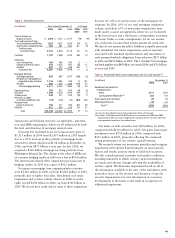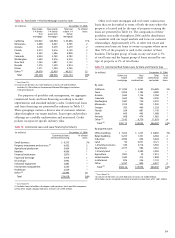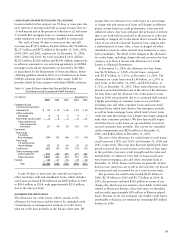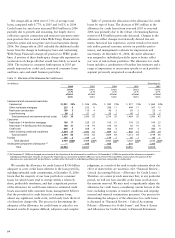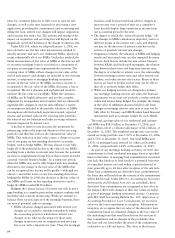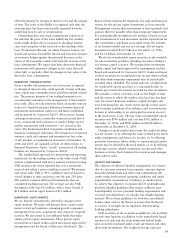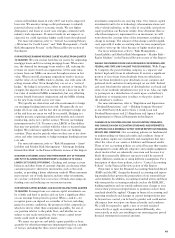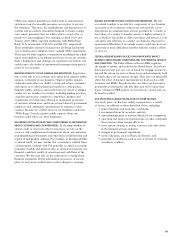Wells Fargo 2006 Annual Report Download - page 57
Download and view the complete annual report
Please find page 57 of the 2006 Wells Fargo annual report below. You can navigate through the pages in the report by either clicking on the pages listed below, or by using the keyword search tool below to find specific information within the annual report.
55
Asset/Liability and Market Risk Management
Asset/liability management involves the evaluation, monitoring
and management of interest rate risk, market risk, liquidity
and funding. The Corporate Asset/Liability Management
Committee (Corporate ALCO)—which oversees these risks
and reports periodically to the Finance Committee of the
Board of Directors—consists of senior financial and business
executives. Each of our principal business groups—Community
Banking (including Mortgage Banking), Wholesale Banking
and Wells Fargo Financial—have individual asset/liability
management committees and processes linked to the
Corporate ALCO process.
INTEREST RATE RISK
Interest rate risk, which potentially can have a significant
earnings impact, is an integral part of being a financial
intermediary. We are subject to interest rate risk because:
• assets and liabilities may mature or reprice at different
times (for example, if assets reprice faster than liabilities
and interest rates are generally falling, earnings will
initially decline);
• assets and liabilities may reprice at the same time but
by different amounts (for example, when the general
level of interest rates is falling, we may reduce rates
paid on checking and savings deposit accounts by an
amount that is less than the general decline in market
interest rates);
• short-term and long-term market interest rates may
change by different amounts (for example, the shape
of the yield curve may affect new loan yields and
funding costs differently); or
• the remaining maturity of various assets or liabilities
may shorten or lengthen as interest rates change (for
example, if long-term mortgage interest rates decline
sharply, mortgage-backed securities held in the securities
available for sale portfolio may prepay significantly earlier
than anticipated—which could reduce portfolio income).
Interest rates may also have a direct or indirect effect on
loan demand, credit losses, mortgage origination volume, the
value of MSRs, the value of the pension liability and other
sources of earnings.
We assess interest rate risk by comparing our most likely
earnings plan with various earnings simulations using many
interest rate scenarios that differ in the direction of interest
rate changes, the degree of change over time, the speed of
change and the projected shape of the yield curve. For exam-
ple, as of December 31, 2006, our most recent simulation
indicated estimated earnings at risk of less than 1% of our
most likely earnings plan over the next 12 months using a
scenario in which the federal funds rate declines 275 basis
points to 2.50% and the 10-year Constant Maturity Treasury
bond yield declines 100 basis points to 3.75%, or a scenario
in which the federal funds rate rises 175 basis points to 7.00%
and the Constant Maturity Treasury bond yield rises 250
basis points to 7.25%, over the same 12-month period.
Simulation estimates depend on, and will change with, the
size and mix of our actual and projected balance sheet at the
time of each simulation. Due to timing differences between
the quarterly valuation of MSRs and the eventual impact of
interest rates on mortgage banking volumes, earnings at risk
in any particular quarter could be higher than the average
earnings at risk over the 12-month simulation period,
depending on the path of interest rates and on our MSRs
hedging strategies. See “Mortgage Banking Interest Rate
Risk” below.
We use exchange-traded and over-the-counter interest rate
derivatives to hedge our interest rate exposures. The notional
or contractual amount, credit risk amount and estimated net
fair values of these derivatives as of December 31, 2006 and
2005, are presented in Note 26 (Derivatives) to Financial
Statements. We use derivatives for asset/liability management
in three ways:
• to convert a major portion of our long-term fixed-rate
debt, which we issue to finance the Company, from
fixed-rate payments to floating-rate payments by
entering into receive-fixed swaps;
• to convert the cash flows from selected asset and/or
liability instruments/portfolios from fixed-rate payments
to floating-rate payments or vice versa; and
• to hedge our mortgage origination pipeline, funded
mortgage loans and MSRs using interest rate swaps,
swaptions, futures, forwards and options.
MORTGAGE BANKING INTEREST RATE RISK
We originate, fund and service mortgage loans, which
subjects us to various risks, including credit, liquidity and
interest rate risks. We reduce unwanted credit and liquidity
risks by selling or securitizing virtually all of the long-term
fixed-rate mortgage loans we originate and most of the
ARMs we originate. From time to time, we hold originated
ARMs in our loan portfolio as an investment for our grow-
ing base of core deposits. We determine whether the loans
will be held for investment or held for sale at the time of
origination. We may subsequently change our intent to hold
loans for investment and sell some or all of our ARMs as
part of our corporate asset/liability management.
While credit and liquidity risks have historically been
relatively low for mortgage banking activities, interest rate
risk can be substantial. Changes in interest rates may poten-
tially impact total origination and servicing fees, the value of
our residential MSRs measured at fair value and the associated
income and loss reflected in mortgage banking noninterest
income, the income and expense associated with instruments
(economic hedges) used to hedge changes in the fair value of
MSRs, and the value of derivative loan commitments extended
to mortgage applicants.
Interest rates impact the amount and timing of origina-
tion and servicing fees because consumer demand for new
mortgages and the level of refinancing activity are sensitive
to changes in mortgage interest rates. Typically, a decline in
mortgage interest rates will lead to an increase in mortgage
originations and fees and may also lead to an increase in ser-
vicing fee income, depending on the level of new loans added
to the servicing portfolio and prepayments. Given the time it


